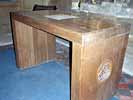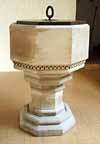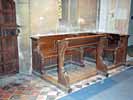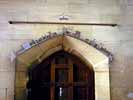Hawksworth St Mary and All SaintsFeatures and Fittings
 Altar table Altar table |
The altar is at the far end of the church directly under the east window. It has been described by the Council for the Care of Churches as not contemporary with the Victorian chancel and to be a modern 20th century oak table probably dating from around 1960. It has the five consecration crosses in the style of a medieval altar, one carved near each corner and one at its centre, and IHS carved on each end panel. It is of interest because it has white marble stone tablet or mensa in the centre of the altar table which is an indication that it was introduced by a vicar in Hawksworth who was very high church at some time.
The altar rails have very thin iron foliate uprights and moulded oak capping. These are thought to date from around 1851 when the chancel was enlarged.
 The font The font |
The font is made of sandstone and has an octagonal stem with a water holding base which probably dates from the 13th or 14th century. The octagonal bowl is 19th century and has plain sides with dogtooth on the lower edge. The stained timber cover is octagonal with a heavy cast metal ring set into the centre. The font originally stood inside the west entrance under the tower but it was moved to the western end of the north aisle during renovations to the church in 1975. The font has been described as a transitional design which combines Norman style with the Early English zigzag dog’s teeth pattern. From the design of the stem, it probably dates from the 13th century. It has eight sides which indicates that it is later than Norman style when fonts were usually rectangular or round, but it is very steep which is consistent with Norman style. From the very beginning of the Early English period, fonts usually had a groove for water therefore the moulded water holding base of this font indicates it is later than the Norman period and dogtooth design was usually seen from around 1200.
Documents record that the font was presented to the church in 1851 by Mrs Lucy Hunt, the patron of the rector, the Rev George Hunt Smyttan. The difference in age between the stem and the bowl would seem to imply that this refers to the presentation of a new bowl only, which utilized a pre-existing stem. The octagonal shape of the bowl is symbolic of new life, the seven days of creation in Genesis and the 8th day of the resurrection.
 Choir stalls Choir stalls |
Inside the chancel the panelled choir stalls are of a very substantial construction with desks with shaped ends and arm rests and traceried end panels. They are made of oak and date from the 19th century, perhaps from 1851 when the chancel was rebuilt.
A wooden chair in the chancel placed on the north side of the altar has inscriptions carved on the back rest and on the inside of both arm rests.
A pine box chair in the chancel situated on the south side of the altar has a hinged seat and simple carvings on the four faces of the box seat.
Joint Stool: This oak stool in the chancel is said to probably be 17th century.
The pews were removed from the church nave in the 1970s and replaced by chairs which are moveable to suit different occasions. From a description of the decorative carving on the original pews, they were believed to be Victorian.
The lectern is a small brass sloping stand on a pedestal which is said to date from the late 19th century. A separate brass table top lectern is stored in the chancel.
Inside the nave near the chancel arch is a litany desk made of oak with a sloped book top and kneeler. The front panel is decorated with carved tracery.
Inside the nave against the east side of the south wall is a simple oak side table with plain legs, shaped brackets and one drawer. It is thought to be of late Georgian date.
Inside the west entrance are two wooden side tables, one on either side, a small wooden table which holds the collection plate and a cupboard for prayer books.
The oak box with iron bands and two metal straps for padlocks placed just inside the west entrance is said to be a 19th century poor box on a pillar, which is described in the listing as a 12th century chamfered and moulded wooden stem.
There is an iron corona lucis with eight candles hanging in the west entrance, which is thought to date from around 1851. There is a similar but smaller iron corona lucis with three candles hanging in the chancel. Around the walls of the church are thirteen metal candle wall sconces of a foliate design consisting of a double in the chancel and on each side of the chancel arch, four singles on the south side of the nave, four singles on the north wall of the north aisle, and one single either side of the nave arch.
Many texts are painted onto the wall of the chancel. These are said to be Victorian and were probably added when the chancel was rebuilt in 1851.
Position in the chancel |
Text |
Over the east windows |
God of God, Light of Light, Very God of Very God |
Over the piscina |
My Blood is Drink Indeed |
Over the south window |
In Him was Life and the Life was the Light of Men |
Over the south doorway |
Glory and Worship are Before Him, A Χ Ω
Power and Honour are in his Sanctuary |
Over the south lancet window |
Beloved Let us Love One Another |
Over the credence |
Offer unto the Lord an Offering in Righteousness |
Over the vestry door |
Let Thy Priests be clothed with Righteousness,
And let Thy Saints Sing with Joyfulness |
Over the organ arch |
God is the King of All the Earth,
Sing Ye Praises with Understanding |
On the wall plate – north side |
Holy Holy Holy Lord God of Hosts |
On the wall plate – south side |
Heaven and Earth are Full of Thy Glory |
On the corbels (4 pieces of stone jutting out of a wall to carry the timber roof frame) |
Glory be to God on High |
 Text over the south Text over the south
chancel doorway |
 Text on the chancel wall Text on the chancel wall
above the piscina |
The text of the Creed on canvas hangs on the north wall of the north aisle and the Lord’s Prayer on canvas hangs on the south wall of the nave. These two texts have a similar appearance and perhaps are two of those supplied around the time of the Parochial Visitation of 1718 which records that texts of the Creed, the Lord's Prayer and the Ten Commandments were to be supplied.
 The Beatitudes The Beatitudes |
In the West Entrance is a painting of the Beatitudes on stone. This text would originally been in a central position on the north wall of the west entrance but after the clock mechanism was installed in the church in 1873, a cupboard was built to the left of the Beatitudes to house the clock weights. The Beatitudes are not seen all that frequently in churches but they were probably done in Victorian times. The stone is grained to look like canvas so perhaps the Beatitudes text was painted on stone as an imitation of the Creed and the Lord’s Prayer that currently hang in the church.
|